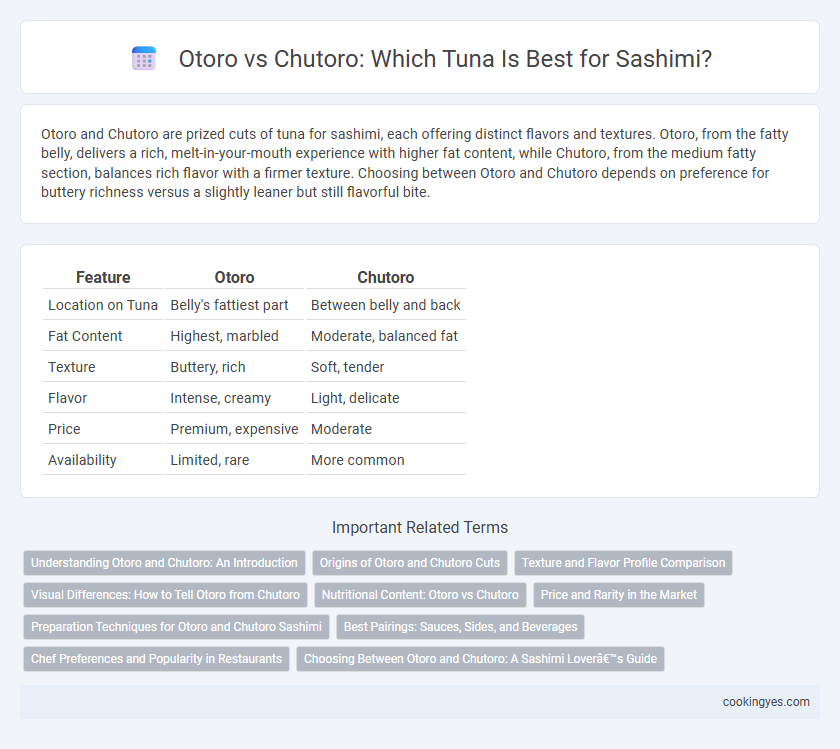Otoro and Chutoro are prized cuts of tuna for sashimi, each offering distinct flavors and textures. Otoro, from the fatty belly, delivers a rich, melt-in-your-mouth experience with higher fat content, while Chutoro, from the medium fatty section, balances rich flavor with a firmer texture. Choosing between Otoro and Chutoro depends on preference for buttery richness versus a slightly leaner but still flavorful bite.
Table of Comparison
| Feature | Otoro | Chutoro |
|---|---|---|
| Location on Tuna | Belly's fattiest part | Between belly and back |
| Fat Content | Highest, marbled | Moderate, balanced fat |
| Texture | Buttery, rich | Soft, tender |
| Flavor | Intense, creamy | Light, delicate |
| Price | Premium, expensive | Moderate |
| Availability | Limited, rare | More common |
Understanding Otoro and Chutoro: An Introduction
Otoro and Chutoro are two prized cuts of tuna used in sashimi, distinguished by their fat content and flavor profiles. Otoro, sourced from the fatty belly portion, offers a rich, buttery texture with intense marbling, making it the most coveted among tuna cuts. Chutoro, found between the lean akami and fatty otoro, balances moderate fat with firm texture, providing a harmonious blend of taste and mouthfeel prized by sushi enthusiasts.
Origins of Otoro and Chutoro Cuts
Otoro and Chutoro are prized cuts from the Bluefin tuna, with Otoro originating from the highly marbled belly section and Chutoro sourced from the area between the belly and the back. Otoro boasts the highest fat content, delivering a rich, buttery texture, while Chutoro offers a balanced flavor profile with moderate fat and firmer meat. Both cuts hold significant culinary importance in Japanese sushi culture, reflecting the distinct quality and flavor variations within the same fish.
Texture and Flavor Profile Comparison
Otoro, the fattiest part of the tuna belly, offers a rich, buttery texture with a melt-in-the-mouth feel and an intensely savory flavor, prized for its high fat marbling. Chutoro, located between the lean akami and Otoro, balances moderate fat content, delivering a tender yet slightly firmer texture and a delicate, slightly sweet flavor profile. The contrast between Otoro's luxurious creaminess and Chutoro's nuanced, mild richness highlights distinct sensory experiences in tuna sashimi enjoyment.
Visual Differences: How to Tell Otoro from Chutoro
Otoro, the fattiest part of tuna belly, exhibits a pale pink color with pronounced marbling of white fat, giving it a rich and creamy appearance. Chutoro, found between the fatty belly and leaner back, displays a deeper pink hue with less visible fat streaks, offering a balance between richness and meatiness. Visually distinguishing Otoro from Chutoro relies on identifying the intensity of marbling and the subtle differences in pink coloration.
Nutritional Content: Otoro vs Chutoro
Otoro, the fattiest part of the tuna belly, contains higher levels of omega-3 fatty acids and calorie content compared to Chutoro, contributing to its rich and buttery texture. Chutoro, found between the fat-rich Otoro and leaner Akami, offers a balanced nutritional profile with moderate fat and protein levels, appealing to those seeking both flavor and a slightly lighter option. Both cuts provide essential nutrients such as high-quality protein, vitamins B6 and B12, and selenium, essential for maintaining energy and immune function.
Price and Rarity in the Market
Otoro, the fattiest portion of bluefin tuna belly, commands a significantly higher price due to its rich marbling and limited availability, making it a rare luxury in sashimi markets. Chutoro, the medium-fatty tuna from the belly to back, is more accessible and moderately priced, offering a balanced flavor with greater market presence. The scarcity of Otoro drives premium pricing and exclusivity, while Chutoro's wider supply supports its steadier demand and affordability.
Preparation Techniques for Otoro and Chutoro Sashimi
Otoro sashimi, derived from the fatty belly of bluefin tuna, requires precise slicing techniques to preserve its delicate marbling and melt-in-the-mouth texture. Chutoro sashimi, sourced from the medium-fat belly, demands a slightly firmer cut to balance its lean and fatty layers, enhancing its complex flavor profile. Both cuts benefit from chilled preparation and sharp, single-stroke knife motions to maintain freshness and integrity in each slice.
Best Pairings: Sauces, Sides, and Beverages
Otoro, the fattiest part of tuna belly, pairs exceptionally well with light soy sauce and a touch of wasabi to highlight its rich, buttery texture, while Chutoro, which balances fat and lean meat, complements ponzu sauce and grated ginger for a refreshing contrast. Side dishes like pickled daikon and seaweed salad enhance the umami profile of both cuts, providing crisp and tangy flavors that cleanse the palate. Sake varieties such as Junmai Daiginjo or a crisp dry white wine elevate the experience, balancing Otoro's richness and complementing Chutoro's delicate flavor without overwhelming either sashimi type.
Chef Preferences and Popularity in Restaurants
Otoro, prized for its rich marbling and buttery texture, is favored by sushi chefs seeking a luxurious, melt-in-the-mouth tuna sashimi experience, making it a staple in high-end restaurants. Chutoro offers a balanced flavor profile with moderate fat content, appealing to chefs who prefer a versatile cut that satisfies a broader range of palates. Popularity in restaurants reflects this divide, with otoro commanding premium prices and exclusive menus, while chutoro enjoys consistent demand in both traditional sushi bars and contemporary eateries.
Choosing Between Otoro and Chutoro: A Sashimi Lover’s Guide
Otoro, the fattiest part of the tuna belly, offers a rich, melt-in-your-mouth texture with a buttery flavor ideal for those seeking intense umami in sashimi. Chutoro, found between the otoro and akami, balances moderate fat content with a firmer texture and a slightly milder taste, appealing to sashimi lovers who prefer a harmonious blend of fattiness and meatiness. Selecting between otoro and chutoro depends on whether you prioritize luxurious richness or a nuanced, balanced sashimi experience.
Otoro vs Chutoro for Tuna Sashimi Infographic

 cookingyes.com
cookingyes.com